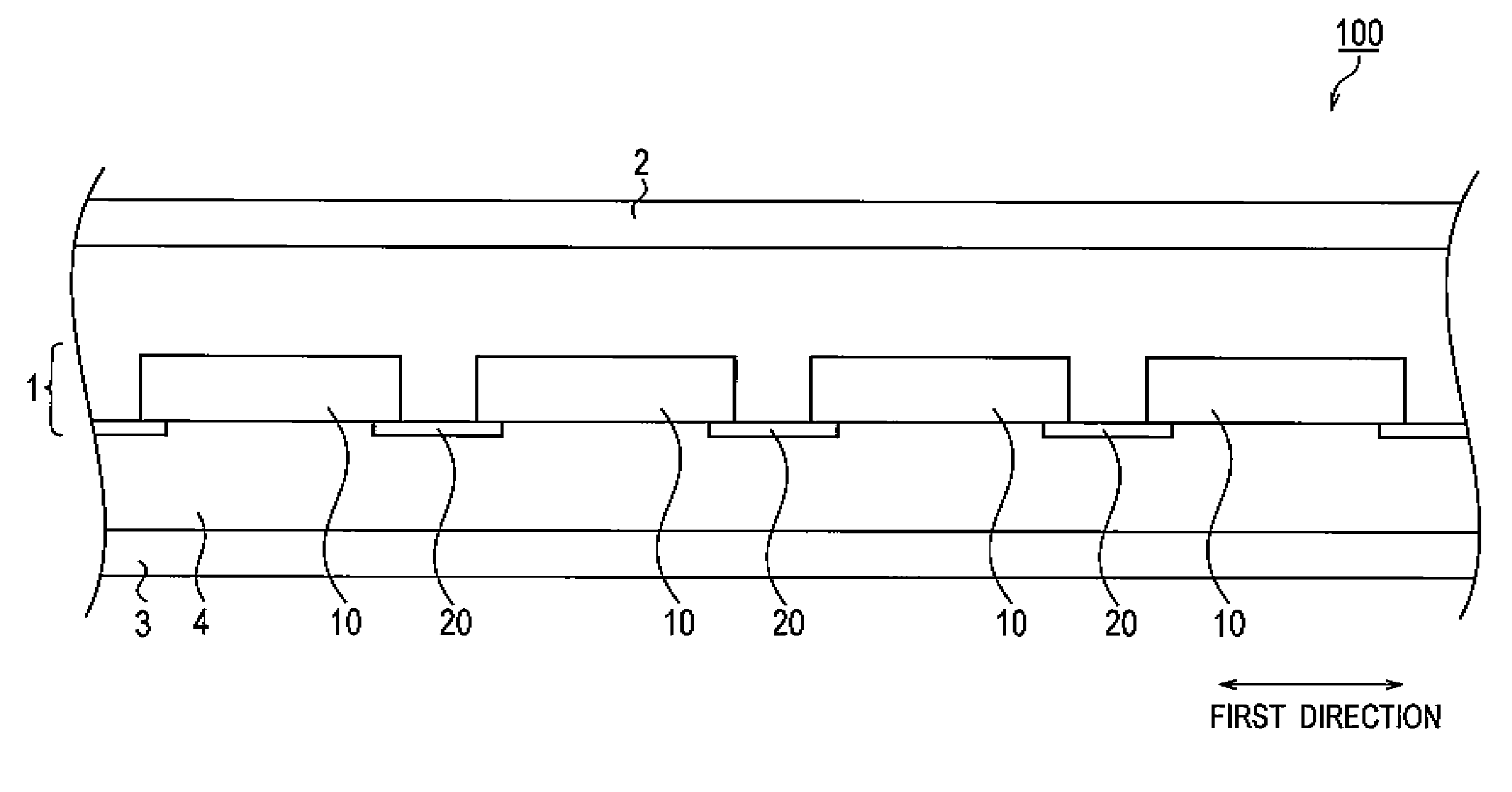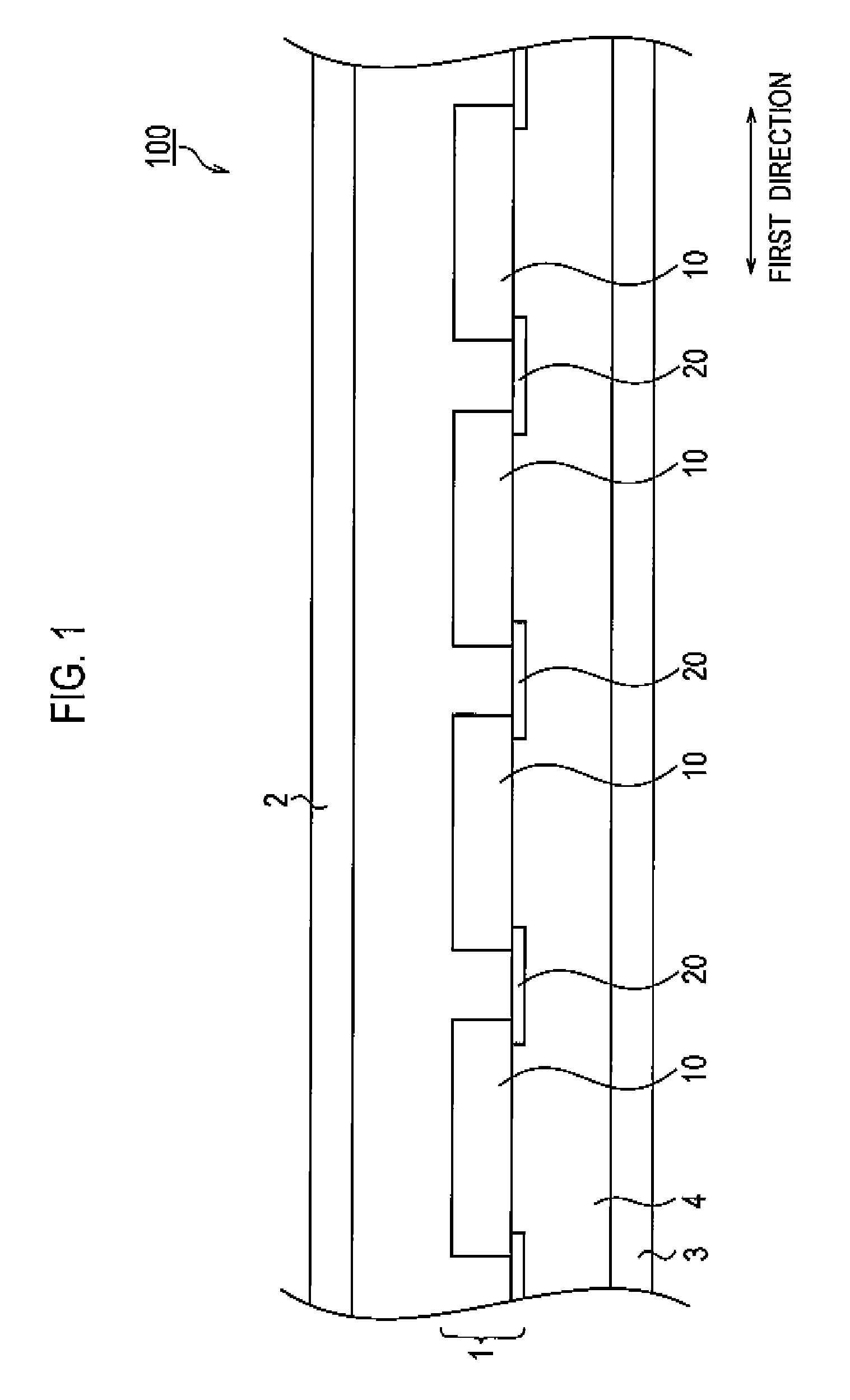Solar cell module
a solar cell module and solar cell technology, applied in the field of solar cell modules, can solve the problems of reducing damage accumulated on the connecting portion of the connecting electrode and the wiring member, etc., and achieve the effect of suppressing the decrease in the power collection efficiency of the solar cell modul
- Summary
- Abstract
- Description
- Claims
- Application Information
AI Technical Summary
Benefits of technology
Problems solved by technology
Method used
Image
Examples
first embodiment
[0028](First Embodiment)
[0029]
[0030]A schematic configuration of a solar cell module according to a first embodiment of the present invention will be described below by referring to FIG. 1. FIG. 1 is a side view of a solar cell module 100 according to the first embodiment of the present invention.
[0031]As shown in FIG. 1, the solar cell module 100 includes a solar cell string 1, a light-receiving-surface-side protection member 2, a back-surface-side protection member 3, and a sealing member 4.
[0032]The solar cell string 1 includes the plurality of solar cells 10 and the plurality of wiring members 20. The solar cell string 1 is configured in such a way that the plurality of solar cells 10 arranged in a first direction are electrically connected to each other through the plurality of wiring members 20. Each solar cell 10 has a light-receiving surface (upper surface in FIG. 1) receiving sunlight and a back surface (lower surface in FIG. 1) provided on the opposite side of the light-re...
second embodiment
[0069][Second Embodiment]
[0070]A second embodiment of the present invention will be described below. Note that, in the following description, a difference between the first and second embodiments will be mainly described. A solar cell module 100 according to the second embodiment of the present invention has a schematic configuration similar to that of the solar cell module 100 shown in FIG. 1.
[0071]FIG. 6 is a plane view of a solar cell string 1 according to the second embodiment of the present invention seen from the back surface side. Note that, in FIG. 6, n-side finer line-shaped electrodes 15 are omitted for simplifying the drawing, as similar to FIG. 4.
[0072]As shown in FIG. 6, each wiring member 20 has first protruding portions 21a and second protruding portions 21b. The first protruding portions 21a protrude toward a solar cell 10a in the first direction. Meanwhile, the second protruding portions 21b protrude toward a solar cell 10b in the first direction.
[0073]First connect...
third embodiment
[0085][Third Embodiment]
[0086]A third embodiment of the present invention will be described below. Note that, in the following description, a difference between the first and third embodiments will be mainly described. A solar cell module 100 according to the third embodiment of the present invention has a schematic configuration similar to that of the solar cell module 100 shown in FIG. 1.
[0087]FIGS. 8A and 8B are plane views of a solar cell string 1 according to the third embodiment of the present invention seen from the back surface side. Note that, in FIGS. 8A and 8B, n-side finer line-shaped electrodes 15 are omitted for simplifying the drawing, as similar to FIG. 4.
[0088]As shown in FIGS. 8A and B, each wiring member 20 includes slit portions 22 which penetrate the wiring member from one of two main planes of the wiring member substantially parallel to the back surfaces of solar cells 10 to the other main plane of the wiring member provided on the opposite side of the one of t...
PUM
 Login to View More
Login to View More Abstract
Description
Claims
Application Information
 Login to View More
Login to View More - R&D
- Intellectual Property
- Life Sciences
- Materials
- Tech Scout
- Unparalleled Data Quality
- Higher Quality Content
- 60% Fewer Hallucinations
Browse by: Latest US Patents, China's latest patents, Technical Efficacy Thesaurus, Application Domain, Technology Topic, Popular Technical Reports.
© 2025 PatSnap. All rights reserved.Legal|Privacy policy|Modern Slavery Act Transparency Statement|Sitemap|About US| Contact US: help@patsnap.com



